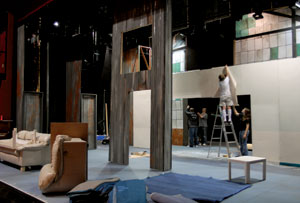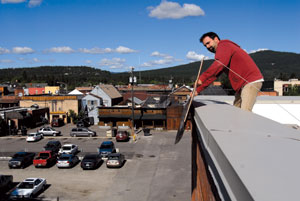For its first full-blown theatrical production, the new Whitefish Performing Arts Center stage already has a new look. Gone are the red and black stage curtains. Enter steel.
Alpine Theatre Project’s first production of the summer resurrects a “City of Steel” on stage. “The Full Monty” musical brings to the stage a downtrodden factory town – full of rusty corrugated metal, drain pipes, brick and graffiti. The set reflects the edgy slang of its steel mill workers, but the characters are filled with heart.
As the musical opens with steelworker Jerry Lukowski singing “Scrap,” the song binds the characters to the set. Jerry’s life is a mess since the mill laid him off. He’ll lose seeing his son if he can’t pay child support. He feels like the scrap metal that surrounds him on stage.
 |
|
Alpine Theatre Project summer intern Kristen Smith, right, helps Sarah Smith hang wall paper on the set of The Full Monty. |
That’s the concept set designer Thomas Bumblaukas from Las Vegas embodied in his scenery. “I didn’t want to see any wood,” explained Betsi Morrison about the artistic direction she gave Bumblaukas. Rather than suggesting steel with gray-painted wood, the pair went for real steel. Corrugated steel trusses replace the legs, or side curtains. Steel walls fly in from the rafters.
Stripped down, textured with glued sawdust and repainted with light gray, gunmetal, brown, rust and copper, the steel emits the burnish of a closed down factory. It’s rough, dented, and beat up. “It looks like the scariest salvage yard you’ve ever been to,” said Marketing Director Nick Spear.
When Terrence McNally, who wrote the book for the Broadway musical, adapted the 1997 comedy film to America, he shifted the venue from Sheffield, England, to Buffalo, N.Y. Both were homes to a steel industry in decline with widespread unemployment.
For six of the steelworkers, being unemployed for 18 months has stripped both their pocketbooks and their dignity. Inspired by a Chippendale-like show, they form their own one-night male striptease act to make some cash. But the guys don’t strut the pecs of the show dancers. To up the ante of their show, they boast that they’ll go totally nude, or “the full monty.”
Lomper, one of the six down-and-outers, is discovered attempting to gas himself in a car. The auto, too, is no facsimile; it’s the real deal. Spear spent weeks scouring local wrecking yards looking for the right vehicle. Finally, he unearthed a vintage mid-80s Yugo with a red-orange “Starsky and Hutch” racing stripe in a Somers junkyard. The model is quite apropos for the play’s set as the Yugo made Time Magazine’s list of the 50 worst cars ever.
 |
|
Marketing Director and guitar player Nick Spear hangs an Alpine Theatre Project sign over the side of Whitefish Performing Arts Center at Central School in Whitefish. |
Spear dropped out the motor and gas tank to hoist the Yugo to the second floor stage via the backstage elevator. Air pads help it slide across the floor where Lomper uses an aluminum dryer hose to gas himself as his newfound friends offer him helpful suicide hints in song.
Despite the musical’s use of MASH humor, the question lingers through the story whether the guys have the chutzpah to reveal all in their act. Designer Rachel Naber Burke orchestrated lights for the famous finale that requires synchronized timing. “We throw all kinds of light on the stage,” said Morrison. “In New York, it’s known as the most important lighting cue on Broadway.”
As a Mylar rain curtain completes the flashy nightclub illusion, a 15-by-22 foot sign sporting human-sized letters spelling out “The Full Monty” drops behind the dancers from the rafters. LaSalle Lighting donated 1,000 bulbs to light up the sign and the theater company rented additional instruments to throw light on stage from the catwalks.
With a full orchestra of 11 brought in for the musical, the pit rips through the finale “Let it Go” – a song that makes you want to dance, too. Spear laughed, “The story is just a heart of gold encased in rusty metal.”